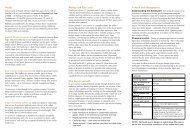Bushland Weeds Manual - Environmental Weeds Action Network
Bushland Weeds Manual - Environmental Weeds Action Network
Bushland Weeds Manual - Environmental Weeds Action Network
Create successful ePaper yourself
Turn your PDF publications into a flip-book with our unique Google optimized e-Paper software.
Foliar spray<br />
Foliage provides a large surface area for uptake of<br />
herbicides. If the climber is growing over low shrubs,<br />
the bulk of the material can be pulled back off and<br />
away from native plants and sprayed. A good penetrant<br />
should always be used. This method is suitable for:<br />
• Dense infestations where no native species are<br />
present and off-target damage will not occur.<br />
• Small infestations in relatively good bushland<br />
where labour is available to carefully pull vines<br />
away from native plants.<br />
Slash and spray<br />
Infestations of plants such as Blackberry, which form<br />
thickets of stems up to two metres high can be difficult<br />
to treat. Larger, dense infestations in highly disturbed<br />
areas are better treated by leaving the plants intact<br />
and spraying with a systemic herbicide. Intact plants<br />
provide more leaf area, increasing the amount of<br />
herbicide that can be taken into the plant (Bruzzese<br />
and Lane 1996).<br />
Chapter 6 Trees, Shrubs and Climbers<br />
Box 6.4 Xylem anatomy and sapwood porosity<br />
In plants, water and its dissolved solutes (including herbicide) are transported along the pathway of least<br />
resistance and this varies depending on the xylem anatomy. In cross section there are three main (and an array<br />
of intermediate) arrangements of vessels and tracheids within woody species: Non-porous, diffuse porous and<br />
ring porous (Chaney 1985, Kozlowski and Pallardy 1997).<br />
Non-porous anatomy is found in gymnosperms, the conifers, which only have small, narrow tracheids for water<br />
uptake. Tracheids produced early in the growing season, the earlywood, have the largest diameters and are the<br />
main pathway for water transport. Three or four annual growth rings of xylem may be active (Kozlowski and<br />
Pallardy 1997).<br />
Diffuse porous anatomy occurs in angiosperm trees, or hardwood species. Vessels, rather than tracheids are<br />
the primary water conductors. In diffuse porous woods, vessels of similar diameter are uniformly scattered in<br />
the early and latewood. The proportion of the sapwood conducting water varies between species, but<br />
commonly vessels found in the outer three or four growth rings are responsible.<br />
Ring porous anatomy also occurs in angiosperms. However, here the vessels of the earlywood are larger in<br />
diameter than those of the latewood. It is these larger vessels of the current growth increment that conduct<br />
99 % of the water and solutes (Zimmerman and Brown 1971, Chaney 1985, Kozlowski and Pallardy 1997).<br />
The movement of sap upwards through the tree also varies between species. Sap may move in a continuous<br />
vertical path, from root to tip, although this is an exception not the rule (Zimmerman and Brown 1971).<br />
Depending on the arrangement of tracheids and vessels, sap may travel in spiral ascent turning right or left,<br />
interlocked ascent and sectorial straight ascent (Chaney 1985, Kozlowski and Pallardy 1997). Spiral ascent<br />
allows the most complete distribution of water from an individual root to many branches (Kubler 1991) and<br />
thus would distribute injected herbicide most widely.<br />
Workers often report variable success rates using herbicide injection tecniques. Knowledge of anatomy and<br />
conduction pattern in the xylem helps tailor our injection technique, maximise its effectiveness and achieve<br />
consistent results. In non-porous and diffuse porous species, herbicide can be injected into the three or four<br />
annual growth rings below the bark. For ring porous species the injected material should be placed just<br />
beneath the bark in the current growth ring. The spacing of injection points can also influence treatment<br />
effectiveness. While there is usually some tangential spread of injected herbicides in the crown (Northcott<br />
1957), trees with straight ascent pathways will often require more injection points than those with a spiral<br />
ascent pathway. If not, the result may be death of the tree in strips, resulting in some dead branches while<br />
others still live. This has been observed in the Flame Tree, Erythrina x skysii (Rod Randall pers. comm. 2001).<br />
Foliar spraying small infestations of Blackberry among<br />
good bushland can result in off-target damage and<br />
accessing the root crown for injection is awkward. A<br />
number of community groups in the Perth region have<br />
found that slashing the plants, carting the bulk away<br />
and spraying regrowth once it is 50-100 cm high is<br />
effective. Blackberries will root readily from cuttings,<br />
so cut material must be removed from the site and<br />
disposed of carefully. Make sure plants are not cut<br />
down while in fruit as their removal from the bushland<br />
will spread the weed. Several follow-up treatments may<br />
be necessary.<br />
Treating resprouts<br />
No matter how good your technique, resprouting of<br />
trees, shrubs and climbers will occur in some species<br />
and/or under some conditions. Follow-up application of<br />
a systemic herbicide to foliage of resprouting plants and<br />
suckers is common practice. However, if the plant was<br />
very large and healthy prior to removal, the amount of<br />
chemical that can be applied to the foliage is likely to be<br />
insufficient to permanently damage the rootstock.<br />
Instead, try clearing away some soil and drilling holes<br />
around the base into the root crown. Fill the holes with<br />
herbicide as for the drill and fill technique.<br />
81



